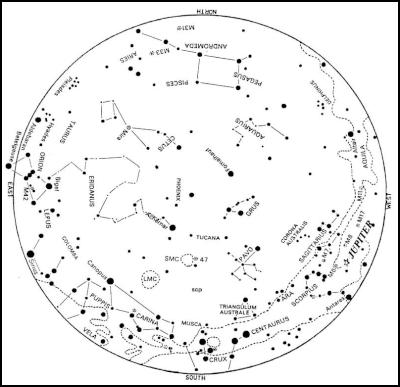Brian Carter: The November Night Sky
The Night Sky
by Brian Carter
The November Night Sky
In the Summer months with warmer nights, looking at the stars and planets becomes a pleasure, instead of a cold ordeal.
Planets
November is a
fair month for viewing the planets. Jupiter, Mars, Venus and
Saturn are visible all month. Mercury will not be seen as it
is visually too close to the
Sun.
Jupiter will be visible in the
early evening in the Western sky. At the start of the month
it sets at 23 25 and at 21 59 by month’s end. Jupiter is
in the constellation of Ophiuchus. Its magnitude slightly
fades from –1.9 to –1.8 by the end of
November.
Mars will be visible for the
last two thirds of the night. At the start of November it
rises at 01 00 and at 23 08 by month’s end. Mars is in the
constellation of Gemini. Its magnitude brightens from –0.6
to –1.3 during the month.
Saturn is visible in
the Eastern morning sky for the last quarter of the night.
It rises at 03 52 at the start of November and at 02 03 by
month’s end. Saturn is in the constellation of Leo, in
which it remains until September 2009. Its magnitude is a
constant 0.8 during the month.
Venus
will be visible in the Eastern morning twilight sky. At the
start of the November it rises at 04 22 and at 03 49 by
month’s end. Venus starts the month in the constellation
of Leo, moving into Virgo on November 4. Venus slightly
fades from –4.4 to –4.2 during
November.
Mercury is visually too close
to the Sun to be seen. Mercury starts the month in the
constellation of Virgo, moving into Libra on November
18.
All times are for Wellington unless
otherwise stated. Other centres may vary by a few
minutes.
Phases of the Moon
Last Quarter –
November 2 at 10 18.
New Moon – November 10 at 12
03.
First Quarter – November 18 at 11 33.
Full Moon
– November 25 at 03 30.
Diary of Astronomical
Phenomena
Nov 2 Mercury stationary against the
background stars at 02 00, as its motion changes from a
Westerly to an Easterly direction.
9 Mercury at greatest
Westerly elongation from the Sun (19°) at 10 00.
10 Moon
at apogee (furthest from the Earth) at 02 00 (Distance =
0.0027184 AU = 406,670 km).
10 New Moon at 12
03.
16 Mars stationary against the background stars at 05
00, as its motion changes from an Easterly to a Westerly
direction.
24 Moon at perigee (closest to the Earth) at
13 00. (Distance = 0.0023877 AU = 357,190 km).
25 Full
Moon at 03 30
29 Venus close to Spica in the morning
twilight.
THIS MONTH’S SKY CHART
This chart shows the sky as it appears at about 22 00 for ~November 15.

Click for big version
How To Use the Sky
Charts
To use the sky chart hold it up to the sky so
that the direction in which you are looking is at the lower
edge of the map. For example, if you are looking at the
western horizon then the map should be held so that the
“WEST” label is at the lower edge. The altitude and
direction of the stars and planets will then be correctly
shown. The centre of the chart will be directly
overhead.
If you would like to receive Carter Observatory’s full e-Newsletter, please email to Astronomy@carterobservatory.org to be included on the list.


 DC Harding: In The Spirit Of Natural Justice
DC Harding: In The Spirit Of Natural Justice Martin LeFevre - Meditations: Animal Encounters During Meditative States
Martin LeFevre - Meditations: Animal Encounters During Meditative States Ian Powell: Gisborne Hospital Senior Doctors Strike Highlights Important Health System Issues
Ian Powell: Gisborne Hospital Senior Doctors Strike Highlights Important Health System Issues Keith Rankin: Who, Neither Politician Nor Monarch, Executed 100,000 Civilians In A Single Night?
Keith Rankin: Who, Neither Politician Nor Monarch, Executed 100,000 Civilians In A Single Night? Eugene Doyle: Writing In The Time Of Genocide
Eugene Doyle: Writing In The Time Of Genocide Gordon Campbell: On Wealth Taxes And Capital Flight
Gordon Campbell: On Wealth Taxes And Capital Flight